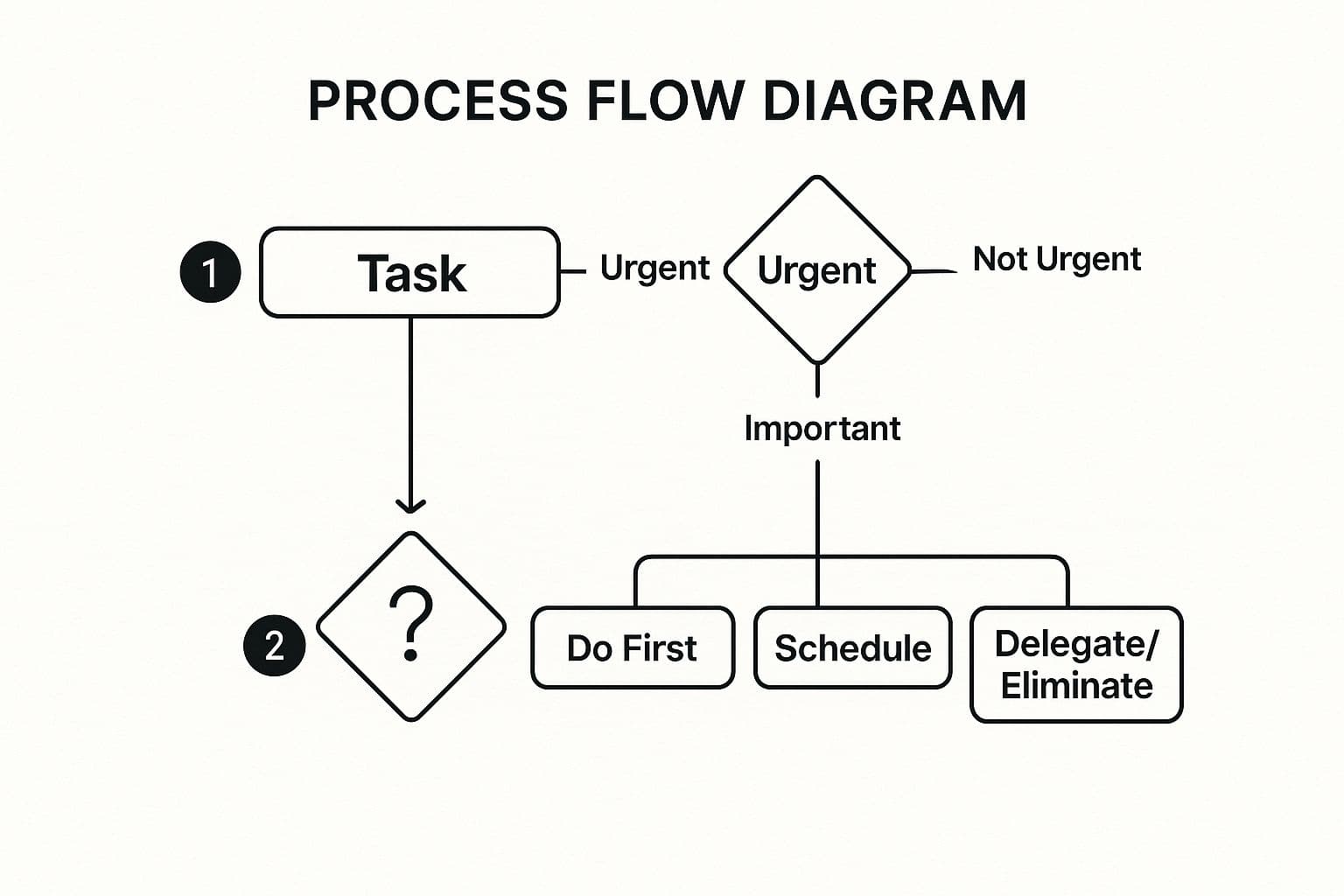Discover effective productivity strategies to enhance your focus and performance. Learn how Fluidwave can help you achieve more each day.
Do less, be more with Fluidwave
Fluidwave combines smart task prioritization with an assistant marketplace — AI and human help, all in one productivity app.
June 10, 2025 (5mo ago)
20 Productivity Strategies to Boost Your Efficiency
Discover effective productivity strategies to enhance your focus and performance. Learn how Fluidwave can help you achieve more each day.
← Back to blog
Supercharge Your Workflow: Essential Productivity Strategies
Feeling overwhelmed? Drowning in to-dos? You're not alone. Many professionals struggle to manage their workload effectively. This curated list provides 10 powerful productivity strategies to help you regain control and achieve peak performance. Learn how to optimize your workflows, prioritize tasks, and make the most of your valuable time. Discover how Fluidwave can amplify these strategies, transforming the way you work.
In this roundup, we'll explore proven techniques like Getting Things Done (GTD), Time Blocking, and the Pomodoro Technique. We'll delve into prioritization methods like the Eisenhower Matrix and the 80/20 Rule. You'll also discover how to leverage the Kanban Method, the Two-Minute Rule, and the Eat That Frog technique for maximum efficiency. Finally, we’ll cover Deep Work and Batch Processing to help you focus and streamline your efforts. These productivity strategies, combined with Fluidwave's intelligent features, will empower you to conquer your to-do list and achieve your goals. Each strategy offers actionable advice and practical tips for immediate implementation. Stop just working hard, and start working smart.
1. Getting Things Done (GTD)
Getting Things Done (GTD), popularized by David Allen, is a powerful productivity strategy offering a comprehensive system for capturing, organizing, and executing tasks. It emphasizes offloading everything from your mind into a trusted system, freeing up mental space for focused work. This shift from remembering what to do to doing it promotes efficiency and reduces stress, making it a highly effective productivity strategy.

GTD involves a five-step workflow: Capture, Clarify, Organize, Reflect, and Engage.** From capturing fleeting thoughts to prioritizing actions and reviewing progress, GTD provides a structured approach to managing all aspects of your workload. This methodology benefits busy professionals, entrepreneurs, and anyone juggling multiple responsibilities. Executives leading complex projects, freelancers handling diverse clients, and students balancing academic and personal commitments can all benefit from the clarity and control GTD provides.
Implementing GTD Effectively
- Start Small: Begin with a simple capture system, such as a notebook or a basic digital tool. Gradually add complexity as you become comfortable with the core principles.
- Weekly Review: Dedicate time each week to review your system, update priorities, and ensure everything is aligned with your goals. This habit is crucial for maintaining an effective GTD system.
- Digital Tools: Leverage digital tools that sync across devices, allowing you to capture and access your tasks from anywhere. Fluidwave's task management features, for instance, can be seamlessly integrated into your GTD workflow.
- Mindset Shift: Focus on the underlying principle of capturing and organizing tasks externally, rather than striving for perfect implementation from the outset. The true power of GTD lies in the mental clarity it provides.
2. Time Blocking
Time blocking is a powerful productivity strategy where you divide your day into distinct blocks of time, each dedicated to a specific task or type of work. Instead of working from a to-do list, you schedule every activity on your calendar, creating a visual roadmap for your day. This proactive approach helps prevent overcommitment and ensures important work gets adequate time allocation, contributing significantly to improved productivity.
Time blocking offers a structured way to manage your workload. CEOs might block time for strategic thinking versus operational tasks. Writers can schedule dedicated blocks for deep work. Consultants might allocate specific hours for client work versus business development. This method allows for focused attention and minimizes distractions, promoting efficiency and reducing the likelihood of context switching.
Implementing Time Blocking Effectively
- Start Small: Begin by blocking 2-3 important activities per day. Gradually increase the number of blocks as you become more comfortable with the technique.
- Transition Time: Include buffer time between different types of work to allow for mental shifts and prevent feeling rushed.
- Color-Coding: Use different colors for work categories to visualize your day's allocation and quickly assess your schedule at a glance.
- Review and Adjust: Regularly review your time blocks and adjust them based on your actual time spent. This iterative process helps refine your schedule and optimize your productivity. Time blocking empowers you to proactively manage your time, enhancing focus and ensuring your most important tasks receive dedicated attention, making it a valuable productivity strategy for busy professionals.
3. Pomodoro Technique
The Pomodoro Technique, developed by Francesco Cirillo, is a time management strategy that breaks work into 25-minute intervals called "pomodoros," separated by short 5-minute breaks. After four pomodoros, a longer break of 15-20 minutes is taken. This structured approach leverages the power of focused bursts of work followed by short periods of rest, enhancing concentration and combating procrastination. This technique is particularly helpful for productivity strategies as it helps maintain a consistent workflow throughout the day.

The Pomodoro Technique benefits individuals prone to distractions or struggling with task initiation. Students can use it for focused study sessions, writers can overcome writer's block with structured writing time, and software developers can tackle coding problems in timed sprints. The cyclical nature of focused work and short breaks helps maintain momentum and prevents burnout, making it a valuable productivity strategy for busy professionals. This technique is especially valuable for those looking for productivity strategies that help maintain consistent output.
Implementing the Pomodoro Technique Effectively
- Customize Intervals: Adapt the 25-minute work and 5-minute break intervals to suit your individual focus patterns. Some individuals may find 45-minute work blocks with 10-minute breaks more effective.
- Use a Timer: A physical timer, or a dedicated app, can create a sense of commitment and urgency, reinforcing the focused work periods. This helps avoid distractions and encourages adherence to the technique.
- Plan Your Pomodoros: Outline your tasks and allocate specific pomodoros to them the night before or at the beginning of your workday. This pre-planning provides structure and clarity.
- Track Your Pomodoros: Monitor the number of pomodoros completed for each task to gain insights into your productivity patterns and identify areas for improvement. This data can inform future planning and task allocation.
4. Eisenhower Matrix (Urgent-Important Matrix)
The Eisenhower Matrix, also known as the Urgent-Important Matrix, provides a simple yet powerful framework for prioritizing tasks based on their urgency and importance. This method, popularized by Dwight D. Eisenhower and later by Stephen Covey, helps individuals and teams focus their energy on activities that truly matter, leading to increased productivity and reduced stress. It categorizes tasks into four quadrants: Do First (urgent and important), Schedule (important but not urgent), Delegate (urgent but not important), and Eliminate (neither urgent nor important).

The infographic visualizes the decision-making process within the Eisenhower Matrix. Beginning with a task, the diagram flows through the decision points of urgency and importance, guiding users to the appropriate action: Do, Schedule, Delegate, or Eliminate. The visual clarifies the steps involved in prioritizing any given task.
Business leaders can leverage the matrix to prioritize strategic initiatives over daily operational issues, ensuring long-term growth. Project managers utilize it to categorize tasks and meet critical deadlines effectively. Entrepreneurs benefit by focusing on growth activities rather than busy work. For more detailed guidance, learn more about the Eisenhower Matrix at Fluidwave's blog post on the time-management quadrant.
Implementing the Eisenhower Matrix Effectively
- Review and Recategorize Tasks Weekly: Regularly reassessing your tasks ensures alignment with evolving priorities. This prevents quadrant creep, where less important tasks become perceived as urgent.
- Spend Most Time in Quadrant 2: Focusing on important but not urgent activities allows for proactive work and prevents crises. This quadrant fosters strategic thinking and long-term planning.
- Be Ruthless about Eliminating Quadrant 4 Activities: These time-wasting tasks drain energy and offer no real value. Eliminating them frees up time for more meaningful endeavors.
- Use Objective Criteria to Determine Importance: Define clear criteria for assessing importance, such as alignment with strategic goals or potential impact. This avoids subjective biases in prioritization.
5. Deep Work
Deep work, a concept championed by Cal Newport, is the practice of focusing without distraction on cognitively demanding tasks for extended periods. It involves creating conditions that allow for sustained concentration on high-value activities that require mental effort and expertise. This contrasts with "shallow work" - tasks that are often logistical and can be performed while distracted. Deep work is a crucial productivity strategy for maximizing output and producing high-quality work.
Deep work is highly effective for complex projects, creative endeavors, and strategic thinking. Examples include researchers producing breakthrough academic papers, software architects designing complex systems, authors writing books, and analysts conducting market research. These professionals thrive in environments that minimize distractions and allow for extended focus. Learn more about Deep Work at Fluidwave's blog post on staying focused.
Implementing Deep Work Effectively
- Start Small: Begin with 60-90 minute deep work blocks and gradually increase the duration as your focus improves.
- Shutdown Ritual: Create a ritual to end your workday, signaling to your brain that it's time to disconnect and recharge. This helps improve focus during deep work sessions.
- Website Blockers: Utilize website blockers during deep work sessions to eliminate digital distractions and maintain concentration.
- Dedicated Space: Establish a consistent deep work location and time. This creates a physical and mental association with focused work, enhancing productivity.
6. Kanban Method
The Kanban Method is a visual workflow management strategy that enhances productivity by providing a clear overview of tasks and their progress. Using a board with columns representing different stages of a process (e.g., To Do, Doing, Done), work items are represented as cards that move across the board as they progress. This visual representation makes it easy to track work, identify bottlenecks, and manage workflow efficiently, making it an excellent productivity strategy.

Originally developed for manufacturing, Kanban has been widely adopted for knowledge work in various fields. Software development teams use it to track features, marketing teams manage campaigns, and editorial teams oversee content pipelines. Even freelancers can leverage Kanban for personal task management. This versatility makes it a valuable productivity strategy for individuals and teams across diverse industries. The Kanban Method's focus on visualizing work, limiting work-in-progress, and continuous improvement helps streamline processes and optimize efficiency.
Implementing Kanban Effectively
- Start Simple: Begin with basic columns like "To Do," "Doing," and "Done." Gradually add more columns as needed to reflect your workflow.
- Limit Work-in-Progress (WIP): Set realistic limits on the number of tasks allowed in each column. This prevents bottlenecks and encourages focus.
- Regular Review: Review and adjust your Kanban board regularly to ensure it accurately reflects your current priorities and workflow.
- Visual Cues: Use different card colors for different types of work or to indicate priority levels. This adds another layer of visual organization.
- Fluidwave Integration: Leverage Fluidwave's project management features to create digital Kanban boards and integrate them with your overall workflow. This allows for seamless collaboration and task tracking within your team.
7. Two-Minute Rule
The Two-Minute Rule, a productivity strategy popularized by David Allen's Getting Things Done (GTD) methodology, presents a simple yet effective principle: If a task takes less than two minutes to complete, do it immediately. This prevents small tasks from accumulating and creating mental clutter or unnecessary administrative overhead from tracking them individually. By addressing these quick tasks right away, you maintain a clearer focus on more demanding work.
This approach contributes to a more streamlined workflow. Instead of adding a quick email response or a minor file organization task to your to-do list, handling it immediately removes the mental burden of remembering it. This principle helps maintain momentum and prevents the feeling of being overwhelmed by a constantly growing list of small, pending items. It fosters a sense of continuous progress and contributes to a more efficient work environment.
Implementing the Two-Minute Rule Effectively
- Be Realistic About Time Estimates: Accurately assess whether a task will truly take less than two minutes. Avoid underestimating and inadvertently spending more time than intended.
- Don't Apply During Deep Work: While effective for quick tasks, avoid interrupting focused work sessions with two-minute tasks. Reserve these for administrative or less demanding periods.
- Batch Similar Two-Minute Tasks: Group similar small tasks together. For example, respond to a batch of short emails at once or make several quick phone calls consecutively.
- Use the Rule During Administrative or Cleanup Time: Dedicate specific time slots for administrative tasks and utilize the Two-Minute Rule to clear out a backlog of quick actions. This contributes to a more organized and efficient workspace. Examples include responding to simple emails immediately, filing documents upon arrival, making quick appointment confirmation calls, or updating calendar entries with location details.
8. Eat That Frog
Eat That Frog, a productivity strategy popularized by Brian Tracy, encourages tackling your most challenging task first thing in the morning. This method, based on the idea that if you eat a live frog first thing, nothing worse can happen all day, leverages peak energy and willpower to overcome procrastination. By conquering the most daunting task early, you create momentum and a sense of accomplishment that propels you through the rest of your day. This method can significantly reduce stress and boost overall productivity.
Eat That Frog is ideal for anyone struggling with procrastination or feeling overwhelmed by large tasks. Busy professionals can use it to address critical projects, entrepreneurs can tackle strategic planning, and students can conquer difficult assignments before easier ones. Sales professionals might make those dreaded cold calls first thing, clearing the way for less demanding tasks later. Learn more about Eat That Frog.
Implementing Eat That Frog Effectively
- Identify Your "Frog": The night before, pinpoint your most important and often most dreaded task. This preparation sets the stage for immediate action in the morning.
- Prepare Everything: Gather all necessary materials the night before. Having everything ready eliminates excuses and facilitates a smooth start.
- Eliminate Distractions: Create a distraction-free environment during your "frog-eating" time. Turn off notifications, silence your phone, and communicate your unavailability to colleagues.
- Celebrate Completion: Acknowledge your accomplishment upon finishing the task. This positive reinforcement strengthens the habit and motivates you to continue the practice. Even small celebrations contribute to the sense of accomplishment.
9. 80/20 Rule (Pareto Principle)
The 80/20 Rule, also known as the Pareto Principle, asserts that roughly 80% of your outcomes stem from 20% of your efforts. This powerful productivity strategy encourages focusing on the vital few activities that yield the most significant results. By identifying and prioritizing these high-impact tasks, you can dramatically improve efficiency and achieve more with less effort, a crucial aspect of effective productivity strategies.
The 80/20 Rule applies across various domains. Sales teams might find that 80% of their revenue comes from 20% of their clients. Software companies could discover that 80% of users utilize only 20% of the features. Even students can benefit by focusing their study time on the 20% of the material that makes up 80% of the exam. This principle highlights the importance of discerning the most valuable activities within any endeavor.
Implementing the 80/20 Rule Effectively
- Identify Key Activities: Regularly analyze your tasks and projects. Track your time and outcomes to pinpoint the 20% of activities generating 80% of your results.
- Prioritize Ruthlessly: Once you've identified your high-impact activities, prioritize them relentlessly. Schedule dedicated time for these tasks and minimize distractions.
- Delegate or Eliminate: Consider delegating or eliminating low-impact activities that consume time without producing significant results. This frees up valuable time for your most productive work.
- Continuous Refinement: Regularly review and adjust your focus as priorities shift. The 20% of high-impact activities may evolve over time, requiring ongoing refinement of your approach.
10. Batch Processing
Batch processing is a powerful productivity strategy that involves grouping similar tasks and completing them in dedicated time blocks. Rather than switching between different types of work throughout the day, you focus on one type of task at a time. This method minimizes context switching, allowing for deeper focus and increased efficiency through repetition and momentum. It’s a valuable strategy for busy professionals seeking to optimize their workflow and enhance productivity.
Batch processing works by leveraging the power of focus and minimizing distractions. By dedicating specific time slots to similar tasks, you reduce the mental overhead required to switch between different modes of thinking. This focused approach enables you to work more efficiently and produce higher-quality output in less time. Examples include processing all emails twice daily, making all phone calls in one dedicated hour, or preparing multiple social media posts in one session.
Implementing Batch Processing Effectively
- Start Small: Begin by batching one type of recurring task. Choose a task that lends itself well to repetition, such as email processing or social media management.
- Scheduled Blocks: Set specific times for batch processing and treat these blocks as appointments. This ensures dedicated time for focused work.
- Preparation is Key: Prepare all necessary materials before starting your batch processing session. Gather relevant documents, templates, or resources to avoid interruptions.
- Templatize: Use templates to speed up similar tasks. This works especially well for repetitive tasks such as email responses, social media posts, or reports.
This strategy particularly benefits professionals who handle numerous repetitive tasks. Executives responding to a high volume of emails, marketers creating social media content, and project managers updating task lists can all significantly benefit from incorporating batch processing into their workflow. This technique allows you to leverage the power of focused work and achieve greater efficiency.
Top 10 Productivity Strategies Comparison
| Method | Implementation Complexity 🔄 | Resource Requirements ⚡ | Expected Outcomes 📊 | Ideal Use Cases 💡 | Key Advantages ⭐ |
|---|---|---|---|---|---|
| Getting Things Done (GTD) | High 🔄🔄🔄 (complex workflow, setup & maintenance) | Moderate (digital tools, weekly reviews) | Reduced mental clutter, reliable task completion 📊 | Complex projects, multi-client management, personal/professional balance | Comprehensive system, mental clarity, scalable ⭐⭐ |
| Time Blocking | Moderate 🔄🔄 (calendar setup & adjustments) | Moderate (calendar apps, color-coding) | Realistic time allocation, reduced decision fatigue 📊 | Strategic work, deep focus tasks, client vs. admin time management | Visual scheduling, work-life boundaries, improved estimation ⭐⭐ |
| Pomodoro Technique | Low 🔄 (simple timer-based cycles) | Low (timer or app) | Increased focus, regular breaks, reduced procrastination 📊 | Study sessions, coding sprints, overcoming writer's block | Easy setup, manageable chunks, prevents burnout ⭐ |
| Eisenhower Matrix | Low to Moderate 🔄🔄 (task categorization effort) | Low (simple quadrant tools or paper) | Effective prioritization, focus on important tasks 📊 | Business prioritization, project management, entrepreneurial focus | Simple, intuitive, reduces busy work ⭐⭐ |
| Deep Work | High 🔄🔄🔄 (habit, environment change) | Moderate to High (distraction blockers, space) | High-quality output, skill development, satisfaction 📊 | Research, coding, writing, analysis requiring focus | High output quality, competitive advantage ⭐⭐⭐ |
| Kanban Method | Moderate 🔄🔄 (board setup and maintenance) | Moderate (tools or physical boards) | Visual workflow clarity, bottleneck detection 📊 | Software teams, marketing workflows, freelance task management | Visual management, controls WIP, flexible ⭐⭐ |
| Two-Minute Rule | Very Low 🔄 (immediate simple action) | Minimal (mental discipline) | Reduced task list bloat, faster small task completion 📊 | Email, quick household or admin tasks | Prevents task overload, immediate wins ⭐ |
| Eat That Frog | Low 🔄 (daily prioritization habit) | Minimal (planning night before) | Important tasks completed first, momentum build 📊 | Sales calls, challenging homework, strategic planning | Ensures priority work, reduces procrastination ⭐⭐ |
| 80/20 Rule (Pareto Principle) | Moderate 🔄🔄 (analysis and ongoing adjustment) | Low to Moderate (tracking & analysis) | Focus on high-impact efforts, improved efficiency 📊 | Sales, software features, study focus, management | Maximizes ROI on effort, identifies vital work ⭐⭐ |
| Batch Processing | Moderate 🔄🔄 (planning and grouping tasks) | Low (time blocks, preparation) | Reduced context switching, improved efficiency 📊 | Email, calls, content creation, admin tasks | Enhances focus, reduces switching costs ⭐ |
Fluidwave: Your AI-Powered Productivity Partner
In today's fast-paced professional landscape, effective productivity strategies are no longer a luxury, but a necessity. This article explored ten powerful methodologies, from the widely adopted Getting Things Done (GTD) method to the focused intensity of Deep Work, offering practical insights into optimizing your workflow. We examined techniques like Time Blocking and the Pomodoro Technique for enhanced time management, as well as prioritization frameworks such as the Eisenhower Matrix and the Pareto Principle. By understanding and implementing these strategies, you can gain significant control over your tasks and time.
Maximizing Your Productivity Potential
Mastering these productivity strategies allows you to move beyond simple task completion and focus on achieving meaningful results. Internalizing concepts like the Two-Minute Rule for handling small tasks quickly, and "Eating the Frog" by tackling challenging tasks first, empowers you to proactively manage your day. The Kanban Method and Batch Processing provide further structure, optimizing workflow and minimizing distractions. The cumulative effect of these strategies is a significant boost in efficiency, enabling you to accomplish more in less time.
Integrating Strategies for Seamless Workflow
Each strategy presents a unique approach to productivity, and their combined power can be truly transformative. However, integrating multiple strategies and consistently applying them can be challenging. This is where Fluidwave becomes invaluable. Fluidwave provides a centralized platform to implement these strategies seamlessly, enabling you to move from theory to practical application. Imagine effortlessly managing your GTD system, scheduling your Deep Work blocks, and tracking your Pomodoro sessions, all within a single, intuitive interface.
From Strategies to Success: The Fluidwave Advantage
Fluidwave enhances your productivity by offering a comprehensive suite of tools designed to support these strategies. It streamlines task management, facilitates automated routines, and even connects you with skilled virtual assistants for seamless delegation. By combining the insights gained from this article with Fluidwave’s intelligent features, you're not just adopting productivity strategies; you’re building a foundation for sustainable success. This empowers you to reclaim your time, sharpen your focus, and achieve your professional goals with greater efficiency and control.
Unlock Your Peak Performance
Ultimately, the goal of implementing productivity strategies is not just about doing more, but about achieving more of what truly matters. It’s about gaining control over your work, reducing stress, and achieving a better work-life balance. By internalizing these principles and leveraging the power of Fluidwave, you can unlock your peak performance and experience the true potential of a truly optimized workflow. Ready to take your productivity to the next level? Explore the power of Fluidwave and discover how you can streamline your workflow and achieve more than ever before. Visit Fluidwave today to learn more and start your free trial.
Do less, be more with Fluidwave
Fluidwave combines smart task prioritization with an assistant marketplace — AI and human help, all in one productivity app.